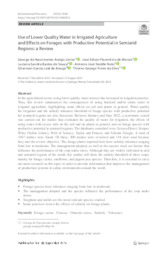Use of lower quality water in irrigated agriculture and effects on forages with productive potential in Semiarid regions: a review.
Use of lower quality water in irrigated agriculture and effects on forages with productive potential in Semiarid regions: a review.
Autoria: ARAÚJO JÚNIOR, G. do N.; MORAIS, J. E. F. de; SOUZA, L. S. B. de; STEIDLE NETO, A. J.; ARAUJO, G. G. L. de; SILVA, T. G. F. da
Resumo: In the agricultural sector, using lower quality water sources has increased in irrigation practice. Thus, this review summarizes the consequences of using brackish and/or saline water in irrigated agriculture, highlighting some effects on soil and plants in general. Water quality for irrigation and the salinity tolerance threshold of forage species with productive potential for semiarid regions are also discussed. Between January and June 2022, a systematic search was carried out for studies that evaluated the quality of water for irrigation, the effects of using water with excess salts on the soil and on plants in general, and on forage species with productive potential in semiarid regions. The databases consulted were: ScienceDirect, Scopus, Wiley Online Library, Web of Science, Taylor and Francis, and Scholar Google. A total of 1567 studies were found. Of these, 200 studies were reviewed and 154 were used because they met the review objective. The forage plants reported here have salinity tolerance ranging from low to moderate. The management adopted, as well as the species used, are factors that influence the performance of the crop under stress. Although they are widely cultivated in arid and semiarid regions of the world, few studies still show the salinity threshold of these crops, mainly for forage cactus, sunflower, and pigeon pea species. Therefore, it is essential to carry out more research on this topic in order to provide information that improves the management of production systems in saline environments around the world.
Ano de publicação: 2023
Tipo de publicação: Artigo de periódico
Unidade: Embrapa Semiárido
Observações
1 - Por padrão são exibidas publicações dos últimos 20 anos. Para encontrar publicações mais antigas, configure o filtro ano de publicação, colocando o ano a partir do qual você deseja encontrar publicações. O filtro está na coluna da esquerda na busca acima.
2 - Para ler algumas publicações da Embrapa (apenas as que estão em formato ePub), é necessário ter, no celular ou computador, um desses softwares gratuitos. Sistemas Android: Google Play Livros; IOS: iBooks; Windows e Linux: software Calibre.
Acesse outras publicações
Acesse a Base de Dados da Pesquisa Agropecuária (BDPA) para consultar o acervo completo das bibliotecas da Embrapa.

